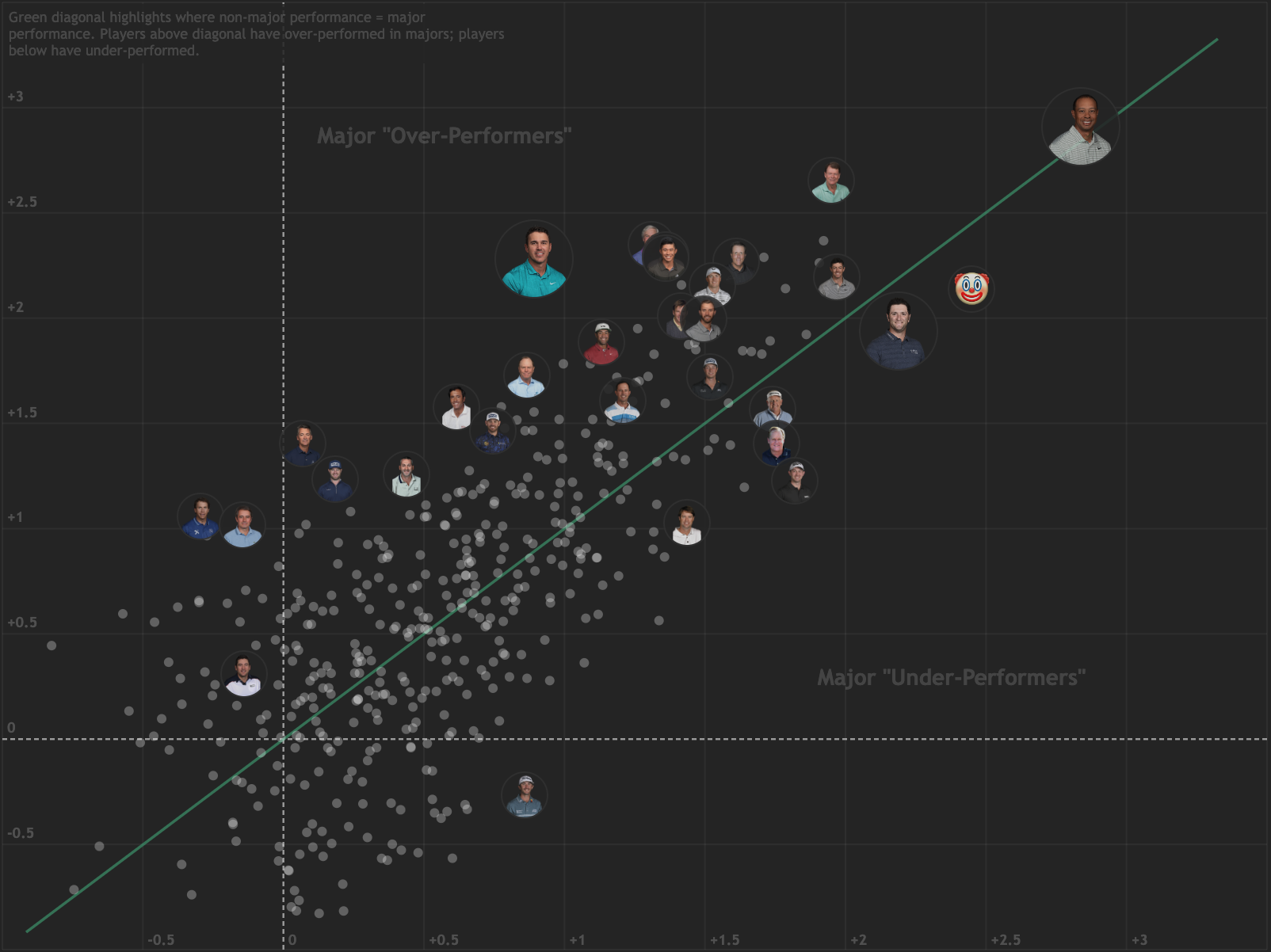
 I.T.N. No. 22
I.T.N. No. 22PUBLISHED August 25, 2020
Inside The Numbers ...
is a brief numerical summary of the current happenings in the world golf, published every Monday — hopefully.
7 SPOTS
Due to (un)popular demand, we are once again
providing live-updating probabilities and
projections for various outcomes related to the FedExCup Playoffs. One such
outcome of interest is the number of positions in the TOUR Championship field that are
not yet determined. It turns out only 7 of the 30 spots at East Lake are realistically up
for grabs; in our 50,000 simulations, the golfers currently ranked 1-20 advanced in every
single simulation, while the 3 golfers in positions 21-23 all
had advance probabilities above 99.95%.
It might be worth bookmarking this post in case a player currently ranked better than 24th fails to advance to East Lake!
It might be worth bookmarking this post in case a player currently ranked better than 24th fails to advance to East Lake!
977 POINTS
Continuing with our FedExCup predictions, it is also interesting to speculate on the point total that will
be required to advance to the Tour Championship. Of course, this point cutoff is itself a random quantity; plotted
below is the point tally of the last player (i.e. 30th in the FedEx rankings at week's end)
to advance to East Lake in each of our 50K simulations:

 The dashed red line indicates the median of the distribution and is equal to
977 points. By looking at the
FedexCup point allocation
for this week we can get a rough sense of the kind of performance required of each player to advance. For example,
Tiger Woods currently sits at 57th in the FedExCup standings with 620 points; therefore, to reach the lowest simulated cutoff of
902 points, Tiger would need to finish in a 2-way tie for 6th (points are averaged across the finish
positions involved in the tie).
The dashed red line indicates the median of the distribution and is equal to
977 points. By looking at the
FedexCup point allocation
for this week we can get a rough sense of the kind of performance required of each player to advance. For example,
Tiger Woods currently sits at 57th in the FedExCup standings with 620 points; therefore, to reach the lowest simulated cutoff of
902 points, Tiger would need to finish in a 2-way tie for 6th (points are averaged across the finish
positions involved in the tie).
It's also worth pointing out that some of the simulations had point cutoffs higher than the current point total of the 17th ranked player in the FedExCup — who, in the note previous to this one, we claimed was guaranteed to advance! Is this a contradiction? No, it just means a scenario wherein the 30th ranked player has more than 1125 points at week's end requires that the current 17th ranked player earns more than that.


It's also worth pointing out that some of the simulations had point cutoffs higher than the current point total of the 17th ranked player in the FedExCup — who, in the note previous to this one, we claimed was guaranteed to advance! Is this a contradiction? No, it just means a scenario wherein the 30th ranked player has more than 1125 points at week's end requires that the current 17th ranked player earns more than that.
9 BETTER PERFORMANCES
With all that has been written and said about Dustin Johnson's 11-stroke victory at last week's
THE NORTHERN TRUST, what may perhaps go unrecognized is that this ridiculous win margin was achieved against one
of the strongest fields in golf. This of course
begs the question: where does DJ's performance rank
historically among the all-time great performances in professional golf? First, for reference,
last week Johnson gained 5.9 strokes per round over the field; we deemed this to be worth
6.5 true strokes-gained per round, as the average player in THE NORTHERN TRUST field was about 0.6
shots better than an average PGA Tour field.
Now, to the good stuff: according to our true strokes-gained metric, which estimates each golfer's performance relative to the average PGA Tour field in that season, there have been just 9 weeklong performances since 1983 better than Johnson's 11-shot romp last week. Predictably, the best strokes-gained performance of all-time belongs to Tiger at the 2000 U.S. Open, where we estimated he gained 7.8 strokes per round over an average PGA Tour player. Henrik Stenson and Phil Mickelson's performances in their duel at the 2016 British Open also came in ahead of DJ, although those were heavily aided by a big wave split. Other notables in the top 9 performances include Tiger's 1997 Masters win, Greg Norman's 1994 win at The Players, and Phil's 2006 win at the BellSouth Classic. Pretty elite company for Deej.
Now, to the good stuff: according to our true strokes-gained metric, which estimates each golfer's performance relative to the average PGA Tour field in that season, there have been just 9 weeklong performances since 1983 better than Johnson's 11-shot romp last week. Predictably, the best strokes-gained performance of all-time belongs to Tiger at the 2000 U.S. Open, where we estimated he gained 7.8 strokes per round over an average PGA Tour player. Henrik Stenson and Phil Mickelson's performances in their duel at the 2016 British Open also came in ahead of DJ, although those were heavily aided by a big wave split. Other notables in the top 9 performances include Tiger's 1997 Masters win, Greg Norman's 1994 win at The Players, and Phil's 2006 win at the BellSouth Classic. Pretty elite company for Deej.
+1.27 TRUE STROKES-GAINED PER ROUND
As those who follow golf closely know, Will Zalatoris is having a special season on the Korn Ferry Tour.
In an old blog,
we documented how rare it is for a golfer on a development tour to perform at the level
of an average PGA Tour professional for the duration of a season; it happened just 22 times on the Korn Ferry
circuit from 2015-2017. So far in the 2020 season, Zalatoris has averaged +1.27
true strokes-gained per round. This is the 22nd
best such average
among golfers on any tour in 2020,
and it is 0.86 strokes per round better than the second-best
average among Korn Ferry Tour players. When you put it all together,
our model ranks
Zalatoris as the 38th best player in the world — just ahead of another promising young player,
Matthew Wolff.
+2.77 TRUE STROKES-GAINED
How messed up have things become since the coronavirus took hold? It's possible that
the best-performing golfer in the world will not be in the 2020 Masters, despite being healthy and willing to play.
Barring a last-minute invitation, Daniel Berger will not be this fall's Masters field; Berger
is currently 6th in our rankings and first in our
trending table, averaging a ridiculous
+2.77 true strokes-gained per round over his last 20 rounds. It's important to notice that I used
the phrase best-performing above; the DG Rankings only use total strokes-gained (adjusted for field strength)
to determine a golfer's position, as total strokes-gained is the measure of performance
that ultimately matters in golf. However,
once we make adjustments for the differential predictive power of the strokes-gained categories, Berger falls to
the 13th-rated golfer by our model. That is, even though the quality of Berger's recent performances is surpassed by only 5
golfers, when it comes to predicting future performance, there are 12 golfers we expect to be better. This is largely driven
by the the fact that, inevitably, a portion of Berger's excellent recent performances
have been driven by putting
— and we know short-term fluctuations in putting are not very predictive of future putting performance.
I.T.N. ARCHIVE
RECOMMENDED BLOGS
Recent Blog Posts
Model Talk Blog
Does our model overvalue leaders?

 Data Visualization Blog
Data Visualization Blog
Skill Distribution of Major Champions







